Dhivya Piraviperumal
SynthDST: Synthetic Data is All You Need for Few-Shot Dialog State Tracking
Feb 03, 2024



Abstract:In-context learning with Large Language Models (LLMs) has emerged as a promising avenue of research in Dialog State Tracking (DST). However, the best-performing in-context learning methods involve retrieving and adding similar examples to the prompt, requiring access to labeled training data. Procuring such training data for a wide range of domains and applications is time-consuming, expensive, and, at times, infeasible. While zero-shot learning requires no training data, it significantly lags behind the few-shot setup. Thus, `\textit{Can we efficiently generate synthetic data for any dialogue schema to enable few-shot prompting?}' Addressing this question, we propose \method, a data generation framework tailored for DST, utilizing LLMs. Our approach only requires the dialogue schema and a few hand-crafted dialogue templates to synthesize natural, coherent, and free-flowing dialogues with DST annotations. Few-shot learning using data from {\method} results in $4-5%$ improvement in Joint Goal Accuracy over the zero-shot baseline on MultiWOZ 2.1 and 2.4. Remarkably, our few-shot learning approach recovers nearly $98%$ of the performance compared to the few-shot setup using human-annotated training data. Our synthetic data and code can be accessed at https://github.com/apple/ml-synthdst
Can Large Language Models Understand Context?
Feb 01, 2024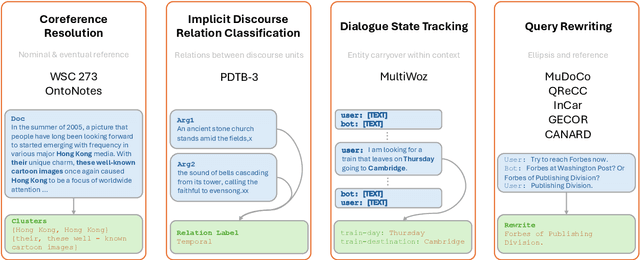
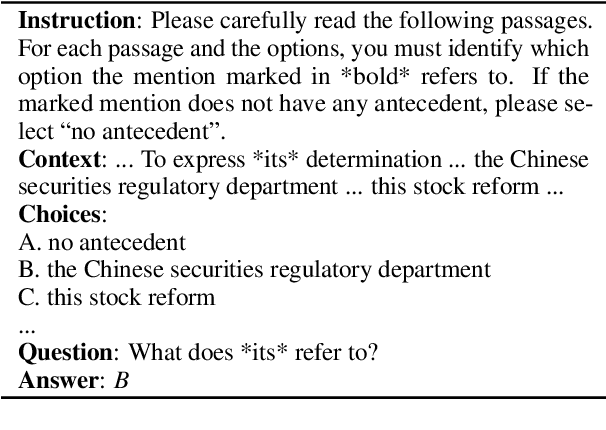
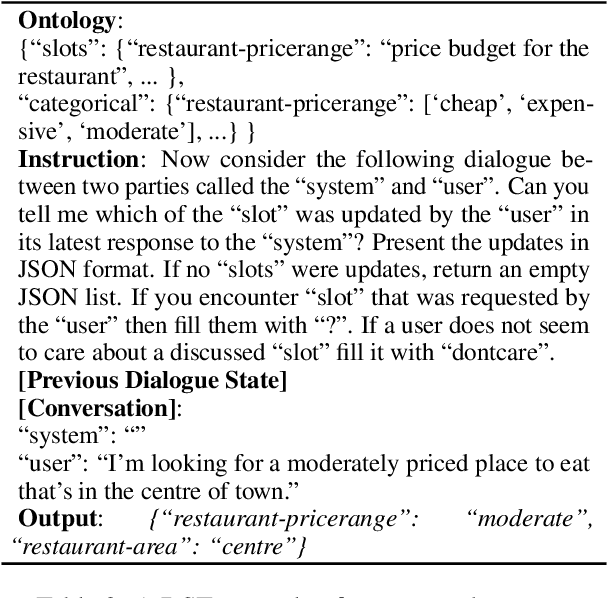
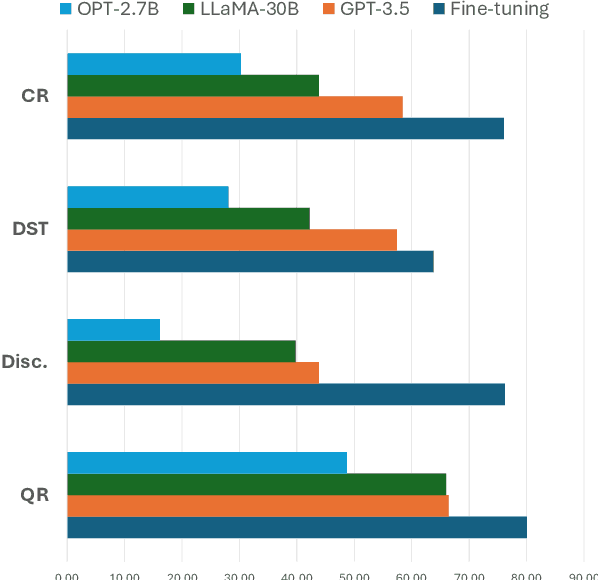
Abstract:Understanding context is key to understanding human language, an ability which Large Language Models (LLMs) have been increasingly seen to demonstrate to an impressive extent. However, though the evaluation of LLMs encompasses various domains within the realm of Natural Language Processing, limited attention has been paid to probing their linguistic capability of understanding contextual features. This paper introduces a context understanding benchmark by adapting existing datasets to suit the evaluation of generative models. This benchmark comprises of four distinct tasks and nine datasets, all featuring prompts designed to assess the models' ability to understand context. First, we evaluate the performance of LLMs under the in-context learning pretraining scenario. Experimental results indicate that pre-trained dense models struggle with understanding more nuanced contextual features when compared to state-of-the-art fine-tuned models. Second, as LLM compression holds growing significance in both research and real-world applications, we assess the context understanding of quantized models under in-context-learning settings. We find that 3-bit post-training quantization leads to varying degrees of performance reduction on our benchmark. We conduct an extensive analysis of these scenarios to substantiate our experimental results.
MARRS: Multimodal Reference Resolution System
Nov 03, 2023



Abstract:Successfully handling context is essential for any dialog understanding task. This context maybe be conversational (relying on previous user queries or system responses), visual (relying on what the user sees, for example, on their screen), or background (based on signals such as a ringing alarm or playing music). In this work, we present an overview of MARRS, or Multimodal Reference Resolution System, an on-device framework within a Natural Language Understanding system, responsible for handling conversational, visual and background context. In particular, we present different machine learning models to enable handing contextual queries; specifically, one to enable reference resolution, and one to handle context via query rewriting. We also describe how these models complement each other to form a unified, coherent, lightweight system that can understand context while preserving user privacy.
STEER: Semantic Turn Extension-Expansion Recognition for Voice Assistants
Oct 25, 2023Abstract:In the context of a voice assistant system, steering refers to the phenomenon in which a user issues a follow-up command attempting to direct or clarify a previous turn. We propose STEER, a steering detection model that predicts whether a follow-up turn is a user's attempt to steer the previous command. Constructing a training dataset for steering use cases poses challenges due to the cold-start problem. To overcome this, we developed heuristic rules to sample opt-in usage data, approximating positive and negative samples without any annotation. Our experimental results show promising performance in identifying steering intent, with over 95% accuracy on our sampled data. Moreover, STEER, in conjunction with our sampling strategy, aligns effectively with real-world steering scenarios, as evidenced by its strong zero-shot performance on a human-graded evaluation set. In addition to relying solely on user transcripts as input, we introduce STEER+, an enhanced version of the model. STEER+ utilizes a semantic parse tree to provide more context on out-of-vocabulary words, such as named entities that often occur at the sentence boundary. This further improves model performance, reducing error rate in domains where entities frequently appear, such as messaging. Lastly, we present a data analysis that highlights the improvement in user experience when voice assistants support steering use cases.
Intelligent Assistant Language Understanding On Device
Aug 07, 2023Abstract:It has recently become feasible to run personal digital assistants on phones and other personal devices. In this paper we describe a design for a natural language understanding system that runs on device. In comparison to a server-based assistant, this system is more private, more reliable, faster, more expressive, and more accurate. We describe what led to key choices about architecture and technologies. For example, some approaches in the dialog systems literature are difficult to maintain over time in a deployment setting. We hope that sharing learnings from our practical experiences may help inform future work in the research community.
CREAD: Combined Resolution of Ellipses and Anaphora in Dialogues
May 20, 2021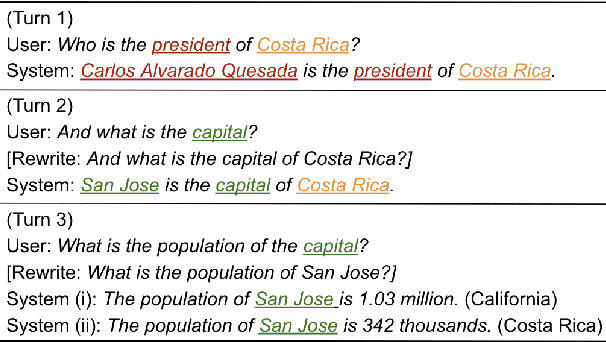
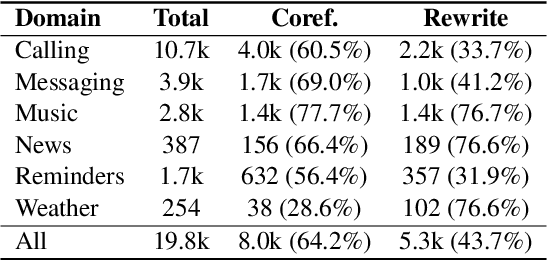
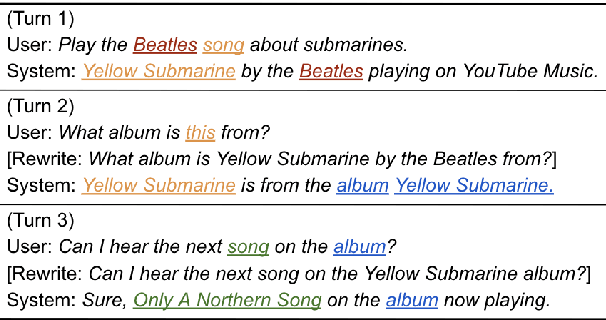
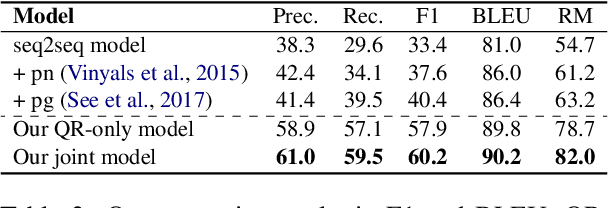
Abstract:Anaphora and ellipses are two common phenomena in dialogues. Without resolving referring expressions and information omission, dialogue systems may fail to generate consistent and coherent responses. Traditionally, anaphora is resolved by coreference resolution and ellipses by query rewrite. In this work, we propose a novel joint learning framework of modeling coreference resolution and query rewriting for complex, multi-turn dialogue understanding. Given an ongoing dialogue between a user and a dialogue assistant, for the user query, our joint learning model first predicts coreference links between the query and the dialogue context, and then generates a self-contained rewritten user query. To evaluate our model, we annotate a dialogue based coreference resolution dataset, MuDoCo, with rewritten queries. Results show that the performance of query rewrite can be substantially boosted (+2.3% F1) with the aid of coreference modeling. Furthermore, our joint model outperforms the state-of-the-art coreference resolution model (+2% F1) on this dataset.
Conversational Semantic Parsing for Dialog State Tracking
Oct 24, 2020


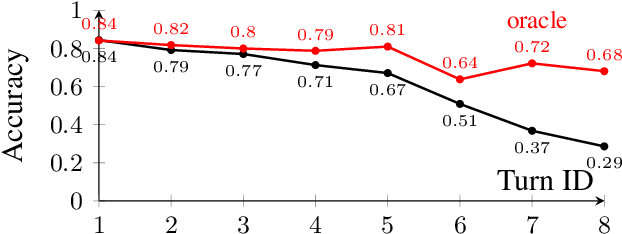
Abstract:We consider a new perspective on dialog state tracking (DST), the task of estimating a user's goal through the course of a dialog. By formulating DST as a semantic parsing task over hierarchical representations, we can incorporate semantic compositionality, cross-domain knowledge sharing and co-reference. We present TreeDST, a dataset of 27k conversations annotated with tree-structured dialog states and system acts. We describe an encoder-decoder framework for DST with hierarchical representations, which leads to 20% improvement over state-of-the-art DST approaches that operate on a flat meaning space of slot-value pairs.
 Add to Chrome
Add to Chrome Add to Firefox
Add to Firefox Add to Edge
Add to Edge